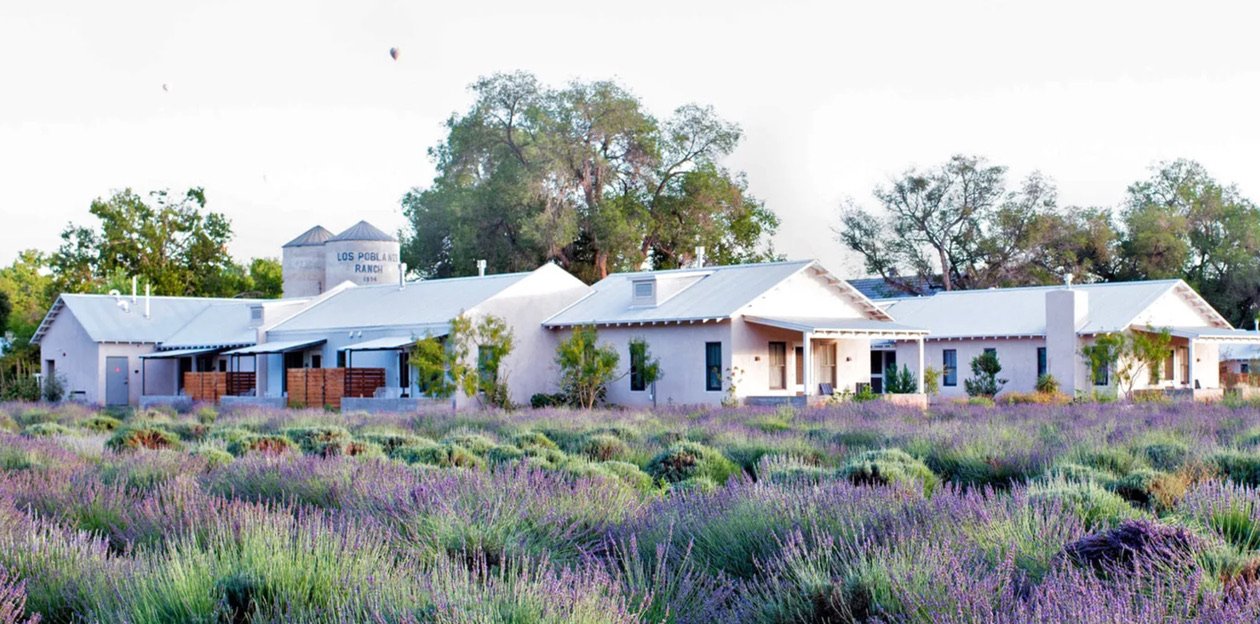The Best Hospitality Secret in America
road trip
I love road trips.
We just wrapped one a few hours ago (hence the late newsletter). We drove from Texas to Idaho—Helen, our two little boys, Lucas (2) and Ezra (6 months), and me.
Very different experience from the solo trips in my bachelor days, or the early-marriage kind when it was just the two of us. This version feels like a real adventure—like when we were kids packed in a van headed to Colorado on a summer trip.
And I love it.
Favorite stop? I’ve got a gem to tell you about…
oasis in the high desert
At the end of a quarter-mile drive lined with towering cottonwoods and elms, just north of Albuquerque in the Rio Grande valley, sits one of my favorite places in America: Los Poblanos.
Twenty-five acres of lavender, kitchen gardens, and formal lawns stretch toward the Sandia Mountains. The smell of lavender and roses drifts through the dry air and stops you in your tracks.
Courtyards bloom with flowers and fruit trees. Mosaic pathways wind between little bridges. Irrigation streams create an intricate network of running water—the lifeblood of this desert oasis.
Around every corner, through every hallway, you find “aha!” moments that make you grin like a kid.
It’s a living, one-of-a-kind landscape that defies easy categorization: organic farm, cultural hub, 45-room historic inn, spa, world-class farm‑to‑fork restaurant, and a retail outpost of lavender goods.
No gates. No pretense. Walking the gardens or dining at Campo, the restaurant, you’ll find yourself among a cross-section of delightful locals who anchor you even further to the soul of this place.
It’s hospitality and tended nature as art form—so many dimensions syncing up without feeling manufactured or too perfect. There’s grittiness. Character.
This is no show farm, it’s the real thing.
And it’s pure magic.
the backstory
How did this place come to be?
In the 1930s, Congressman Albert Simms and his wife Ruth transformed an 800‑acre Spanish land grant into an experimental farm and cultural oasis. They hired Territorial Revival architect John Gaw Meem to create their hacienda and cultural center, "La Quinta”. And they built utilitarian USDA dairy barns for a herd of dairy cows they brought from Illinois.
But by the late 90s, the once-respectable farm was weeks from being turned into a suburban cookie-cutter subdivision.
Enter Penny and Armin Rembe. New Mexico transplants since the ‘60s, they’d fallen deeply in love with their adopted state and wanted to make a difference. They cared, and they acted.
Pooling resources with extended family, they bought the farm for a modest sum. Then came the hard part: How could it pay for itself?
They weren’t wealthy enough to make this a hobby.
the lavender gamble
The Rembe family moved onto property and began studying biodynamic and organic farming. They needed low-water crops that could create value-added products. The answer seemed elegantly simple.
Lavender. And they planted fields and fields of it.
Inspired by European agritourism (still rare in America—you’ve heard my soap box!) they dreamed of a hospitality experience rooted in a working farm.
It took seven years just to get the zoning and permits for a proper inn. And this was Albuquerque—not exactly a tourist magnet.
After the kids moved out to attend college, they opened a five-room bed and breakfast. It lost money for five straight years. But they persevered, building trust and demonstrating the positive impact it would have on the local community.
Finally, they got the green light.
That’s when their son Matt moved back, leaving a budding art brokerage career in NYC to “help for a few months.” But he saw the unique opportunity, felt the calling, and stayed to take the vision to the next level.
Then they really started dreaming. And doing.
seven streams, one ecosystem
Fast-forward twenty years: Los Poblanos is a masterpiece of integrated hospitality.
46 guest rooms. An architectural gem. Their own bakery, butchery, spa, farm shop, distillery. And a restaurant unlike anything else in the country.
Seven business verticals supporting one incredible ecosystem and brand.
The impact? 330 employees. A steady stream of guests from all over the world. But walk through the kitchen, or really anywhere on the property, and you’ll understand something deeper.
The food is grown steps from your table or sourced from neighboring farms. Every dish tells a story, and each one is so inspired. Alive.
I know this is extremely high praise, but Helen and I agree: Campo surpasses every other restaurant we’ve experienced in this country.
Each morning or afternoon, the entire restaurant team spends 30-45 minutes working in the gardens. Weeding, planting, harvesting. No one is exempt. And they love it.
The food doesn’t lie. Neither do the smiles on everyone’s faces. Most of them have been there a decade or so.
Matt and his nephew Jack Rembe. Truly wonderful folks.
final thoughts
Albuquerque might not be on your bucket list. It wasn’t on mine.
But do yourself the favor and book that ticket. You’ve got to experience this. Doesn’t matter what business you’re in, it’s a work of art. A case study in creating beauty, sustainability, and long-term vision.
I promise you won’t regret it.
I’ll sum all of it up like this: in my opinion, Los Poblanos is the best-kept hospitality secret in America. And no, I wasn’t paid to write any of this:)
It’s just extraordinary.
Thank you to the Rembe family and all the wonderful folks who make this place come alive.
The world needs more of you.
More beauty, more character, more long-term thinking.
An impromptu sundown dance on the lawn of La Quinta






